Anaheim, California
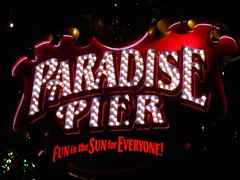 Given Disney’s frequent self-congratulatory tendencies, it is with some surprise that when they finally decided to construct an amusement park land that’s a simulation of an amusement park, they didn’t use their own neighboring Disneyland as their model. Just imagine the possibilities: Tour the authentically inauthentic jungles of Adventurelandland, and then marvel at yesterday’s vision of today in Tomorrowlandland! If they could have made a “Disneylandland”, it probably would have been the most interesting and honest themed environment they’d ever design. It would allow them to finally declare without veiled pretense that they alone are the ultimate synthesis of pop-culture trash and the cornerstone of Californian identity. Meanwhile I would enjoy getting my mind blown by the meta-surrealness of the whole thing.
Given Disney’s frequent self-congratulatory tendencies, it is with some surprise that when they finally decided to construct an amusement park land that’s a simulation of an amusement park, they didn’t use their own neighboring Disneyland as their model. Just imagine the possibilities: Tour the authentically inauthentic jungles of Adventurelandland, and then marvel at yesterday’s vision of today in Tomorrowlandland! If they could have made a “Disneylandland”, it probably would have been the most interesting and honest themed environment they’d ever design. It would allow them to finally declare without veiled pretense that they alone are the ultimate synthesis of pop-culture trash and the cornerstone of Californian identity. Meanwhile I would enjoy getting my mind blown by the meta-surrealness of the whole thing.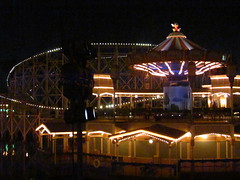 What magnitude of vortex in the space-time continuum would be created by a hyperreal interpretation of the ultimate example of hyperreality?
What magnitude of vortex in the space-time continuum would be created by a hyperreal interpretation of the ultimate example of hyperreality?
At the very least it probably would have shut up a number of the Disney-faithful critics of California Adventure that no Disney property should be tainted by the inclusion of the “unthemed” amusement park rides that were designed for the beach-boardwalk styled Paradise Pier. Seriously, guys, the theme of the park is California culture, and amusement boardwalks are a part of California culture. How on earth does a themed landscape of Roller Coasters and Ferris Wheels not belong here? Last I checked Long Beach, Venice, Santa Monica, Santa Cruz, et al, are all still part of the Pacific shelf. None of them have fallen off, yet.______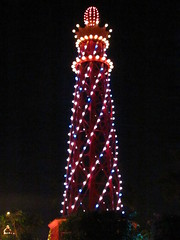
Actually, that’s too plainly obvious for me to think it’s a legitimate response to what the criticism is actually getting at, so I’ll try again. Seriously, guys, you are latently implying that traditional amusement parks are inherently of poor taste, stigmatizing them to be of inferior social and cultural standing compared to the suburban class-superiority of modern resort theme parks. That’s not a criticism of Disney. It’s a criticism of anything that isn’t Disney! Nothing else at Disneyland has ever been anything more than an imitation of popular culture, and to deny the boardwalk amusement park a place at these theme parks is to disavow that part of society as dirty and ugly at a fundamentally base aesthetic level, so that even a ‘clean’ version is still trash. A part of society which Disney itself is a branch of! Besides, since Disney’s model of theme park design makes it impossible to construct more than a small handful of thematically integrated rides at a level that would satisfy the fans without a budget exceeding several billion dollars, it was the traditional amusement parks that ultimately saved California Adventure by allowing the Imagineers to glut the western edge of the park with numerous attractions you can actually ride.
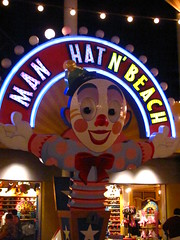 Now that I’ve spent all my breath defending Paradise Pier, I’m going to flip sides and tear it down. The place does a really shitty job paying ‘homage’ to the historical California amusement boardwalks and piers. It looks more like a candy store exploded in Six Flags. Nor do they watch their visual sightlines, leaving a large concrete condominium hotel (owned by Disney) taking a prominent position along the back of the park. I’m sad to say a lot of the fan base’s criticisms of Paradise Pier do have merit. The attempt to modernize a historical amusement pier results in something that looks like an airbrushed caricature of any generic movie set pier, and the off-the-shelf rides serve little purpose other than to fill in space. I can only imagine how much worse it was with an S&S tower ride crudely themed to a carnival Hi-Striker game in the middle of it. They seem to be trying to shift the visual design from the flashiness of Pacific Park to the vintageness of The Pike as part of their billion dollar renovation, which is the right general strategy. However, this revision to Victorian architecture is entirely superficial, just a few set dressings to make the pier look more dignified and upper class to visitors who don’t realize it is totally lacking in any genuine historical content.
Now that I’ve spent all my breath defending Paradise Pier, I’m going to flip sides and tear it down. The place does a really shitty job paying ‘homage’ to the historical California amusement boardwalks and piers. It looks more like a candy store exploded in Six Flags. Nor do they watch their visual sightlines, leaving a large concrete condominium hotel (owned by Disney) taking a prominent position along the back of the park. I’m sad to say a lot of the fan base’s criticisms of Paradise Pier do have merit. The attempt to modernize a historical amusement pier results in something that looks like an airbrushed caricature of any generic movie set pier, and the off-the-shelf rides serve little purpose other than to fill in space. I can only imagine how much worse it was with an S&S tower ride crudely themed to a carnival Hi-Striker game in the middle of it. They seem to be trying to shift the visual design from the flashiness of Pacific Park to the vintageness of The Pike as part of their billion dollar renovation, which is the right general strategy. However, this revision to Victorian architecture is entirely superficial, just a few set dressings to make the pier look more dignified and upper class to visitors who don’t realize it is totally lacking in any genuine historical content.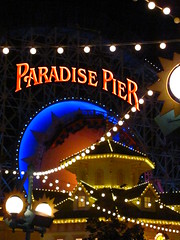 As a student of amusement park history, I think there was a huge opportunity
As a student of amusement park history, I think there was a huge opportunity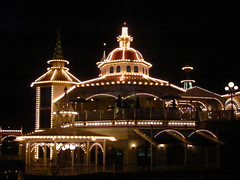 missed to resurrect lost treasures of California like the Cyclone Racer, the L.A. Thompson Scenic Railway, or the Laff in the Dark. I think Disney could have taken the concepts of these rides and done something inventive for a 21st century audience, plus it would have allowed the historical authenticity the Imagineers are always lusting after. Imagine, real wooden structures at Disney, just like the originals! Instead they landed us with a Mack Wild Mouse and a cartoon carousel.
missed to resurrect lost treasures of California like the Cyclone Racer, the L.A. Thompson Scenic Railway, or the Laff in the Dark. I think Disney could have taken the concepts of these rides and done something inventive for a 21st century audience, plus it would have allowed the historical authenticity the Imagineers are always lusting after. Imagine, real wooden structures at Disney, just like the originals! Instead they landed us with a Mack Wild Mouse and a cartoon carousel.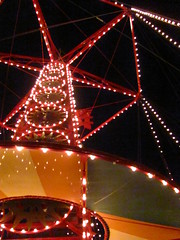
The one attraction they sorta got right was the Golden Zephyr,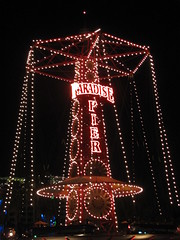 a Harry Traver Circle Swing that was once popular at amusement parks. Having recently been on an authentic 1904 version at Blackpool Pleasure Beach, I was appreciative that they got the mechanics correct. While it’s just like the real thing, there’s also a downside… it’s just like the real thing. There’s a reason they stopped building these nearly eighty years ago. They’re not very thrilling. The silver steel 12-person aeroships have a lot of inertia so it’s rather hard to get much of a swing going. You just circle around in the air only a few feet from the safety of the platform, eliciting a nice breeze and panoramic view of Paradise Bay, and that’s about it. On the plus side, the combination of high capacity and being not a particularly popular ride to begin with means that the queue should rarely be a problem.
a Harry Traver Circle Swing that was once popular at amusement parks. Having recently been on an authentic 1904 version at Blackpool Pleasure Beach, I was appreciative that they got the mechanics correct. While it’s just like the real thing, there’s also a downside… it’s just like the real thing. There’s a reason they stopped building these nearly eighty years ago. They’re not very thrilling. The silver steel 12-person aeroships have a lot of inertia so it’s rather hard to get much of a swing going. You just circle around in the air only a few feet from the safety of the platform, eliciting a nice breeze and panoramic view of Paradise Bay, and that’s about it. On the plus side, the combination of high capacity and being not a particularly popular ride to begin with means that the queue should rarely be a problem.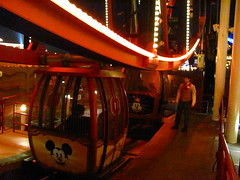
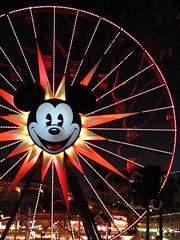 Mickey’s Fun Wheel is arguably the most iconic centerpiece of the park, usurping the somewhat reclusive and very grey Grizzly Peak for that distinction. The make-over from Sun Wheel to Fun Wheel seems to have been one of the more positive changes. Not because I hate the sun and need more Mickey Mouse around the parks (and I’m not sure of the logic of swapping
Mickey’s Fun Wheel is arguably the most iconic centerpiece of the park, usurping the somewhat reclusive and very grey Grizzly Peak for that distinction. The make-over from Sun Wheel to Fun Wheel seems to have been one of the more positive changes. Not because I hate the sun and need more Mickey Mouse around the parks (and I’m not sure of the logic of swapping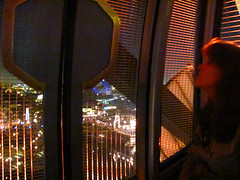 the sun and Mickey’s head between the Ferris Wheel and California Screamin’s loop and calling that an ‘improvement’). But because it got an attractive LED
the sun and Mickey’s head between the Ferris Wheel and California Screamin’s loop and calling that an ‘improvement’). But because it got an attractive LED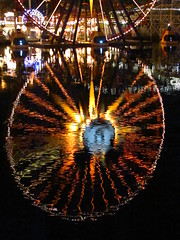 lighting package that makes the geometric figure come alive at night. While it looks purty from across the bay, up close in person it could use a lot more plussing. The queue, potentially interesting for its subaquatic location, is mostly surrounded by hard concrete and temporary hand railings, and the gondola cars have an awful metal mesh over all the openings that make picture-taking near impossible with anything larger than a camera-phone, even straining ordinary spectatorship. The slow, continuously moving rotation means everyone gets exactly one cycle. I like this for efficiency reasons, but it also means that if you chose the roller cars you only get two moments where you rush towards the end and fling the car nearly halfway to horizontal. The fixed cars aren’t nearly as thrilling but there’s a better view at the top, if you’re able to enjoy it through all the wires.
lighting package that makes the geometric figure come alive at night. While it looks purty from across the bay, up close in person it could use a lot more plussing. The queue, potentially interesting for its subaquatic location, is mostly surrounded by hard concrete and temporary hand railings, and the gondola cars have an awful metal mesh over all the openings that make picture-taking near impossible with anything larger than a camera-phone, even straining ordinary spectatorship. The slow, continuously moving rotation means everyone gets exactly one cycle. I like this for efficiency reasons, but it also means that if you chose the roller cars you only get two moments where you rush towards the end and fling the car nearly halfway to horizontal. The fixed cars aren’t nearly as thrilling but there’s a better view at the top, if you’re able to enjoy it through all the wires.
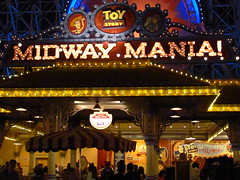 We’d skip the Silly Symphony Swings, Jumpin’ Jellyfish and King Triton’s Carousel, which didn’t offer anything I couldn’t find at a local carnival except for twenty minute queues, and move on to the 2008-opened Toy Story Midway Mania. It seems as if Pixar is determined to turn California Adventure into a personal showcase (Cars Land, A Bug’s Land, Monster’s Inc., Turtle Talk with Crush, the Up playground), and so they must also find synergistic opportunities on an old amusement boardwalk. Themed to a set of carnival midway games, this interactive dark ride uses the latest 3D dark ride technology to produce what essentially amounts to five minutes playing on a Nintendo Wii. Needless to say, this makes it the most popular attraction at California Adventure, and is the one attraction where the use of FastPasses would be most highly recommended.
We’d skip the Silly Symphony Swings, Jumpin’ Jellyfish and King Triton’s Carousel, which didn’t offer anything I couldn’t find at a local carnival except for twenty minute queues, and move on to the 2008-opened Toy Story Midway Mania. It seems as if Pixar is determined to turn California Adventure into a personal showcase (Cars Land, A Bug’s Land, Monster’s Inc., Turtle Talk with Crush, the Up playground), and so they must also find synergistic opportunities on an old amusement boardwalk. Themed to a set of carnival midway games, this interactive dark ride uses the latest 3D dark ride technology to produce what essentially amounts to five minutes playing on a Nintendo Wii. Needless to say, this makes it the most popular attraction at California Adventure, and is the one attraction where the use of FastPasses would be most highly recommended.
We enter beneath the California Screamin’ superstructure, the stand-by queue a long loop around a sheltered promenade with lots of cute toy-sized details; i.e. “cut here” markings on the cardboard packaging walls. The centerpiece is a larger-than-life Mr. Potato Head animatronic character interacting with guests in line and spectators on the midway. This is one of the most impressive pieces of technical equipment in the park, with digitally projected eyes, fully synchronized lips, and extremely fluid arm movements, completely absent of the rigid mechanical shuttering I’m accustomed to on most of these props, but still able to make strong, forcible hand gestures. The character tries to “interact” with spectators using Don Rickles’ deadpan comic delivery, but this tends to fail because people don’t intuitively realize they’re supposed to respond to him. Instead we watch silently with a quizzical look on our faces, waiting for this piece of technology to demonstrate some other programmed feature for us. The “no response” collection of automated lines get recycled fast, and then he breaks into an annoying off-tone song that tends to promote those holding up the queue to forward movement once again.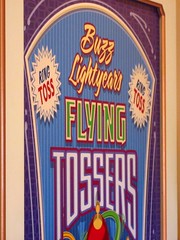 Actually, the biggest laugh I found in the queue seemed to be unintentional: a poster for a Toy Story midway game called (I kid you not) “Flying Tossers”.
Actually, the biggest laugh I found in the queue seemed to be unintentional: a poster for a Toy Story midway game called (I kid you not) “Flying Tossers”.
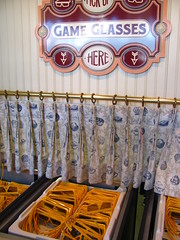 The dark ride vehicles are linked into pairs, with each car holding four people, two sitting back to back on each side. Inside the ride are a series of video screens that the vehicles park in front of, one screen directly in front of each set of riders. Each seat has a mounted plastic gun with a pull-chord trigger, and we are given targets to blast on the screen in a first-person shooter format. Good, old fashioned, American fun, right? The various virtual projectiles (pies, darts, balls, etc.) are rendered with real-time physics, so that the targets you knock down will bounce and ricochet off
The dark ride vehicles are linked into pairs, with each car holding four people, two sitting back to back on each side. Inside the ride are a series of video screens that the vehicles park in front of, one screen directly in front of each set of riders. Each seat has a mounted plastic gun with a pull-chord trigger, and we are given targets to blast on the screen in a first-person shooter format. Good, old fashioned, American fun, right? The various virtual projectiles (pies, darts, balls, etc.) are rendered with real-time physics, so that the targets you knock down will bounce and ricochet off 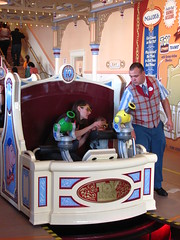 other objects in the scene, giving the various Sids in the audience a chance to delight in some mayhem. My aunt Christine’s strategy
other objects in the scene, giving the various Sids in the audience a chance to delight in some mayhem. My aunt Christine’s strategy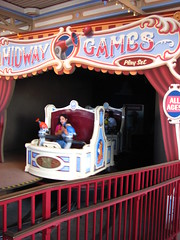 was to carefully pick out a target (the point values vary and there are also a few “Easter Eggs”), aim, shoot, and then move on to scanning for the next good target. My strategy, however, was to just go into each scene John Rambo style, guns ablazin’, spraying custard projectiles across anything unlucky enough to end up on the wrong side of my crosshairs. Yippee ki-yay, rubber duckies! This strategy ended up being the winning strategy, although it tanked my accuracy rating to only 50%. Also, my only take-home was a free sample of carpal tunnel syndrome.
was to carefully pick out a target (the point values vary and there are also a few “Easter Eggs”), aim, shoot, and then move on to scanning for the next good target. My strategy, however, was to just go into each scene John Rambo style, guns ablazin’, spraying custard projectiles across anything unlucky enough to end up on the wrong side of my crosshairs. Yippee ki-yay, rubber duckies! This strategy ended up being the winning strategy, although it tanked my accuracy rating to only 50%. Also, my only take-home was a free sample of carpal tunnel syndrome.
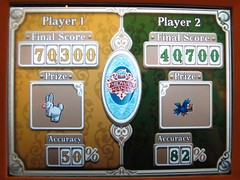 The ride’s fun but at the end of it there’s a nagging feeling that it’s not the sort of fun I paid for in a trip to Disneyland. Midway Mania is basically the exact same kind of fun as it is to play a new videogame at a friend’s party with slightly inebriated vision, and despite the high level of interactivity neither of us had much desire for a repeat experience. So much of what we call entertainment these days involves looking at refreshing pixilated screens, and when I go to a theme park I’d prefer something that’s real and tactile in front of me. The dark ride format is largely wasted in this regard. There’s almost no riding or scenery, as the cars spend most of their time parked at a standstill so you can shoot at a screen for thirty seconds before they speed off
The ride’s fun but at the end of it there’s a nagging feeling that it’s not the sort of fun I paid for in a trip to Disneyland. Midway Mania is basically the exact same kind of fun as it is to play a new videogame at a friend’s party with slightly inebriated vision, and despite the high level of interactivity neither of us had much desire for a repeat experience. So much of what we call entertainment these days involves looking at refreshing pixilated screens, and when I go to a theme park I’d prefer something that’s real and tactile in front of me. The dark ride format is largely wasted in this regard. There’s almost no riding or scenery, as the cars spend most of their time parked at a standstill so you can shoot at a screen for thirty seconds before they speed off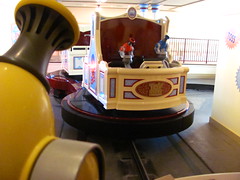 to the next game. The only reason I can think of that necessitates a ride system is because each scene is nothing more than the same game with different dressings and movie characters, so you need to have some literal sensation of “moving on” so the repetition feels more substantial than reaching the next level in an iPhone game app.
to the next game. The only reason I can think of that necessitates a ride system is because each scene is nothing more than the same game with different dressings and movie characters, so you need to have some literal sensation of “moving on” so the repetition feels more substantial than reaching the next level in an iPhone game app.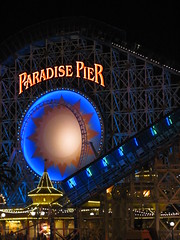 The experience probably would not have been compromised very much if they just built a large arcade with 3D shooter games, but since you wouldn’t have to queue 45 minutes for that, no one would think it was any good.
The experience probably would not have been compromised very much if they just built a large arcade with 3D shooter games, but since you wouldn’t have to queue 45 minutes for that, no one would think it was any good.
At last we arrive at California Screamin’, California Adventure’s signature original thrill ride wholly unique to the property, which also happens to have the second longest track length of any steel roller coaster in North America; it is also the longest roller coaster with inversion(s) anywhere in the world. 6000+ feet of track should automatically make California Screamin’ pretty special in the world of roller coasters, right?
The problem is: California Screamin’ is not very special. When I first learned that length statistic I couldn’t believe it was true.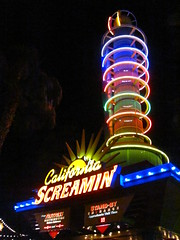 How could a layout have that much track but so little substance? It’s a double out-and-back that features a launch, a loop, and…? The coaster does indeed take a respectable two minutes to get from launch position to the final brakes – quite a long time for continuous forward momentum, by roller coaster standards at least – so it’s not like we’re somehow being cheated. And observing from the ground in person I was struck by how much the coaster structure dominates the midway on all sides. The solution to this discrepancy was answered by an initial front seat ride, revealing to me that a lot of the layout is unmemorable fluff that pads out the ride time.
How could a layout have that much track but so little substance? It’s a double out-and-back that features a launch, a loop, and…? The coaster does indeed take a respectable two minutes to get from launch position to the final brakes – quite a long time for continuous forward momentum, by roller coaster standards at least – so it’s not like we’re somehow being cheated. And observing from the ground in person I was struck by how much the coaster structure dominates the midway on all sides. The solution to this discrepancy was answered by an initial front seat ride, revealing to me that a lot of the layout is unmemorable fluff that pads out the ride time.
The progression of the layout is quite uncomplicated, centralized around the singular vertical loop as the moment of climax, with the launch/lift hill combo escalating drama in the first half, and a series of bunny hops and helix finale acting as a steady denouement before the brakes. What are missing from this equation are the flat turns, which we greet after every one or two ‘straight’ elements (including the many block brakes), and it is in these wide, drawn out curves that a lot of that 6072 feet of track is spent.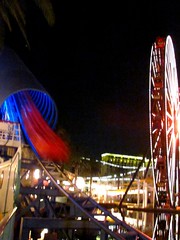 They are pretty fast paced and riders remain excited and engaged through the whole experience (aided by an onboard audio soundtrack that keeps the synapses racing even when the coaster cars themselves are starting to let off the gas), but this non-stop circling around the midway fails to leave a memorable impression due to their amorphous, force-differential shaping and resulting neutral G-forces.
They are pretty fast paced and riders remain excited and engaged through the whole experience (aided by an onboard audio soundtrack that keeps the synapses racing even when the coaster cars themselves are starting to let off the gas), but this non-stop circling around the midway fails to leave a memorable impression due to their amorphous, force-differential shaping and resulting neutral G-forces.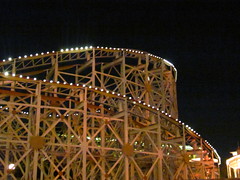
Before this becomes too negative, I must commend California Screamin’ for its merits, which are numerous. As I already noted, the layout elements, as pointless as many of them might be, are at least sequenced in a very logical manner that progresses in a neat and tidy dramatic arc. Emotions swing back and forth from slow escalating tension to fast adrenal release, thanks in part to the LIM technology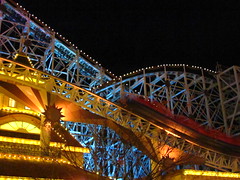 that allows for an extended midcourse pause – and even the persistently recurring block brakes allow a moment to ‘set-up’ the next action sequence. The water-level launch kicks things off to a rousing start after a nervously playful introduction, a small kick of airtime present on the first big hill, and the penultimate set of bunny hops (with an appropriate musical development) brings it all home; although the helix is a bit of a limp noodle as a ‘grand finale’. Lastly, even though it’s ‘just’ a simple vertical loop, the presentation and anticipation of this lonely inversion works so well that when it finally arrives, it feels almost as awe-inducing as Magic Mountain’s Revolution. Almost.
that allows for an extended midcourse pause – and even the persistently recurring block brakes allow a moment to ‘set-up’ the next action sequence. The water-level launch kicks things off to a rousing start after a nervously playful introduction, a small kick of airtime present on the first big hill, and the penultimate set of bunny hops (with an appropriate musical development) brings it all home; although the helix is a bit of a limp noodle as a ‘grand finale’. Lastly, even though it’s ‘just’ a simple vertical loop, the presentation and anticipation of this lonely inversion works so well that when it finally arrives, it feels almost as awe-inducing as Magic Mountain’s Revolution. Almost.
Plus it’s all very smooth. I must have gotten too accustomed to the Intamin vibration on Cedar Point’s coasters, and I was particularly dreading the boxy, old-make OTSH rolling stock. But these fears were totally without warrant, as the wheels rolled as if on glass, and the seats were MUCH more spacious than the hideous, “modernized” 2nd Gen trains on Colossus, et al. They also allowed room for an in-coach zipper compartment for loose items, an invaluable feature for speeding dispatch times and reducing the risk of loss, damage, or theft… why on Earth don’t more parks besides Disney use these?!?
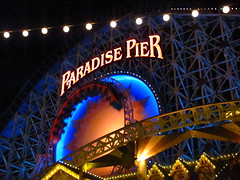 The on-board music also did much to aid the riding experience. It’s mixed and synchronized to make sure it matches perfectly with the riding experience, slowing down, speeding up, and introducing variations exactly along with the layout. The music’s absence was sorely noted whenever we got a cycle with the speakers turned off, which unfortunately constituted the majority of our rides. The only thing that holds the soundtrack back from elevating the ride to the next level (à la Space Mountain) are the corny arrangements, a combination of tinkly carnival music for the slow parts and a fairly generic hard rock sound for the fast parts. Neither convinced me it wasn’t originally written for a cheap videogame company with the instrumentation arranged by the composer’s MacBook Pro.
The on-board music also did much to aid the riding experience. It’s mixed and synchronized to make sure it matches perfectly with the riding experience, slowing down, speeding up, and introducing variations exactly along with the layout. The music’s absence was sorely noted whenever we got a cycle with the speakers turned off, which unfortunately constituted the majority of our rides. The only thing that holds the soundtrack back from elevating the ride to the next level (à la Space Mountain) are the corny arrangements, a combination of tinkly carnival music for the slow parts and a fairly generic hard rock sound for the fast parts. Neither convinced me it wasn’t originally written for a cheap videogame company with the instrumentation arranged by the composer’s MacBook Pro.
 Once the pros have been summed with the cons, California Screamin’ equates to a solid, enjoyable three-star thrill ride. I think many would agree. There’s very little the coaster gets wrong… but there’s very little that exceeds expectations, either. This goes back to my original point: 6000+ feet of track and a dual launch/lift system should have been epic. Given the financial and creative resources available when it was being developed, the possibilities could have been nearly limitless. It hopefully doesn’t take much imagination to realize that. I think where California Screamin’ went wrong was when Disney committed themselves not to building a roller coaster, but to building an imitation of a roller coaster. The ride appears just a little bit too perfect. The layout design seems to be based on an animator’s sketch of what the ideal
Once the pros have been summed with the cons, California Screamin’ equates to a solid, enjoyable three-star thrill ride. I think many would agree. There’s very little the coaster gets wrong… but there’s very little that exceeds expectations, either. This goes back to my original point: 6000+ feet of track and a dual launch/lift system should have been epic. Given the financial and creative resources available when it was being developed, the possibilities could have been nearly limitless. It hopefully doesn’t take much imagination to realize that. I think where California Screamin’ went wrong was when Disney committed themselves not to building a roller coaster, but to building an imitation of a roller coaster. The ride appears just a little bit too perfect. The layout design seems to be based on an animator’s sketch of what the ideal roller coaster would look like from across the Paradise Pier harbor, and this curbs the ability to experiment with potentially more effective layout ideas. Satisfaction of spectators was a higher priority than satisfaction of riders. Visual aesthetic theory is very well understood by Disney and accordingly is placed on a high pedestal. Roller coaster aesthetic theory (i.e. psychological motives, emotional progressions dependant on layout variations, etc.) is not very well understood by anyone, and it’s easy to overlook even though this is arguably the most important aspect of a visitors experience. No one realized how much unexploited possibility remained left sitting on the table once the project was given the green light with 40% of the track consisting of flat banked curves that only looked beautiful from the ground. Lucky for Disney, that fairly well describes
roller coaster would look like from across the Paradise Pier harbor, and this curbs the ability to experiment with potentially more effective layout ideas. Satisfaction of spectators was a higher priority than satisfaction of riders. Visual aesthetic theory is very well understood by Disney and accordingly is placed on a high pedestal. Roller coaster aesthetic theory (i.e. psychological motives, emotional progressions dependant on layout variations, etc.) is not very well understood by anyone, and it’s easy to overlook even though this is arguably the most important aspect of a visitors experience. No one realized how much unexploited possibility remained left sitting on the table once the project was given the green light with 40% of the track consisting of flat banked curves that only looked beautiful from the ground. Lucky for Disney, that fairly well describes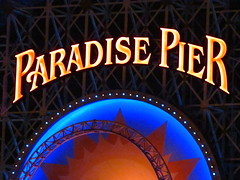 the state of modern roller coaster design as a whole, where rides are generally chosen based on how cool they look on a blueprint or brochure, and don’t always correlate to how cool they are to actually ride. California Screamin’ is the poster child for this trend by being the only roller coaster themed to look like a different roller coaster.
the state of modern roller coaster design as a whole, where rides are generally chosen based on how cool they look on a blueprint or brochure, and don’t always correlate to how cool they are to actually ride. California Screamin’ is the poster child for this trend by being the only roller coaster themed to look like a different roller coaster.
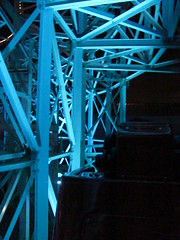 Somewhere in the subtext of all of this commentary is an interesting contradiction that how beautiful a roller coaster appears is often unrelated, if not an inverse factor, of how beautiful a roller coaster is to ride. The eye is attracted to continuity and symmetry (maybe in the pursuit of some metaphysical artistic ideal, maybe from a genetic selection process to weed out deformities in breeding), while the adrenal gland is activated by the opposite: unexpected discontinuities that appear to threaten the subject’s existence.
Somewhere in the subtext of all of this commentary is an interesting contradiction that how beautiful a roller coaster appears is often unrelated, if not an inverse factor, of how beautiful a roller coaster is to ride. The eye is attracted to continuity and symmetry (maybe in the pursuit of some metaphysical artistic ideal, maybe from a genetic selection process to weed out deformities in breeding), while the adrenal gland is activated by the opposite: unexpected discontinuities that appear to threaten the subject’s existence.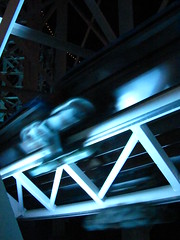 For example, one could probably make an argument that Mean Streak is one of the most beautiful coasters ever built, even though the riding experience is generally considered one of the worst in the world. In fact, few enthusiasts will even naturally find it ‘beautiful’ anymore due to their first-hand experience that makes them nauseous at the very sight of the coaster, conditioned Clockwork Orange style. Imagine if someone was a coaster enthusiast only for looking at them, but never riding them, what their top ten list would be? I suspect California Screamin’ would be a contender, but even then I am uncertain about its artificial steel-copies-wood beauty when I compare it to the authentic originals, particularly the work of Prior and Church who were able to work beauty into all aspects of their creations, no matter if your viewpoint was on or off ride. Maybe if Disney wasn’t always so obsessed with producing an ‘improved’ imitation of these originals, they could have for once achieved the unaffected beauty of the real thing. But then people would complain because “that’s not Disney”.
For example, one could probably make an argument that Mean Streak is one of the most beautiful coasters ever built, even though the riding experience is generally considered one of the worst in the world. In fact, few enthusiasts will even naturally find it ‘beautiful’ anymore due to their first-hand experience that makes them nauseous at the very sight of the coaster, conditioned Clockwork Orange style. Imagine if someone was a coaster enthusiast only for looking at them, but never riding them, what their top ten list would be? I suspect California Screamin’ would be a contender, but even then I am uncertain about its artificial steel-copies-wood beauty when I compare it to the authentic originals, particularly the work of Prior and Church who were able to work beauty into all aspects of their creations, no matter if your viewpoint was on or off ride. Maybe if Disney wasn’t always so obsessed with producing an ‘improved’ imitation of these originals, they could have for once achieved the unaffected beauty of the real thing. But then people would complain because “that’s not Disney”.
With all of my ride reviews completed for California Adventure, I’ve noticed a recurring theme at this park. Nothing here is absolutely terrible (well, maybe apart from Monsters, Inc.) but nothing is remarkably outstanding, either. My favorite attractions were all flawed in some way, and the least flawed were attractions whose type I don’t particularly care for to begin with. The experience is the Disney equivalent of Purgatory. It’s the place where all the mediocre rides go to wait for their spiritual cleansing (in the form of a $1.1 billion renovation project), while we as visitors wait for our own ascension into the Utopia on the other side of the divide. (It’s called “Disneyland”.) The capstone of a visit to Disney California Adventure was the ultimate embodiment of this waiting for purification: World of Color.__________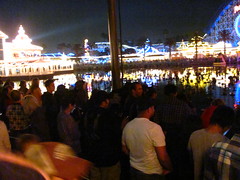
We’d have liked to ride California Screamin’ a few more times, but they cut off access to the queue over an hour before the evening water and light show was scheduled to begin. While this is ostensibly in reaction to crowd control issues as people begin to take their places around Paradise Bay, I suspect in reality it only compounds the problem, as we (along with everyone else in the area) were then forced to begin our purgatorial waiting around the lagoon earlier than we might have otherwise preferred.
The game theorist in me always takes pleasure in observing the “irrationality” of such group behavior. Everyone’s self-interest maximizing desire to secure the best viewing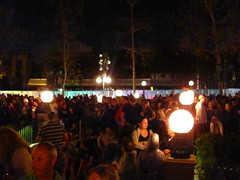 spots for themselves results in a negative net loss for all the participants, because the distribution ratios of prime and subprime real estate will always be the same no matter when people choose to arrive, but the total amount of time that everyone has to stand around waiting goes way up (compared to if everyone was able to agree to arrive only ten minutes in advance; on average you’d have the same luck in finding a good spot but everyone also would have been able to enjoy the previous hour riding attractions instead). The problem with game theory is that when competing in a normal form strategy matrix such as this, an understanding of the group dynamics does absolutely nothing to aid in improving my own individual strategy. I’m only awarded the pleasure of enjoying the bitter irony of it all.
spots for themselves results in a negative net loss for all the participants, because the distribution ratios of prime and subprime real estate will always be the same no matter when people choose to arrive, but the total amount of time that everyone has to stand around waiting goes way up (compared to if everyone was able to agree to arrive only ten minutes in advance; on average you’d have the same luck in finding a good spot but everyone also would have been able to enjoy the previous hour riding attractions instead). The problem with game theory is that when competing in a normal form strategy matrix such as this, an understanding of the group dynamics does absolutely nothing to aid in improving my own individual strategy. I’m only awarded the pleasure of enjoying the bitter irony of it all.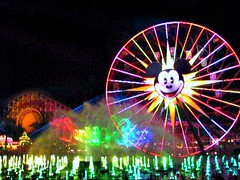
After nearly an hour guarding a valuable spot along one of the tiers of banisters, salvation finally arrives as the lights dim and the announcer makes the introductions, causing the throngs of spectators to start chattering excitedly before there’s a sudden hush, and the fountains start squirting. The technology on display is quite impressive. World of Color consists of a wide variety of highly synchronized water fountains that fill Paradise Bay, including some that are capable of shooting water nearly 200 feet high, and a giant fanned cascade along the back that acts as a movie projection screen. There are also a few additional effects such as fire cannons, lasers, and some weird retracting globe thingies, but these are used sparingly and the show is almost exclusively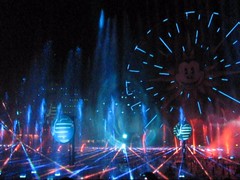 a supersized dancing waters production. The comparison my aunt made was to the fountain show at the Bellagio in Las Vegas, but noted that the big difference here was the use of high-powered, multicolor LED at the base of each fountain so that the star of the show isn’t even the water, but all the vibrant colors. It makes sense, right? The name is World of Color, not World of Water. That show’s at Universal Studios and stars a Kevin Costner impersonator.
a supersized dancing waters production. The comparison my aunt made was to the fountain show at the Bellagio in Las Vegas, but noted that the big difference here was the use of high-powered, multicolor LED at the base of each fountain so that the star of the show isn’t even the water, but all the vibrant colors. It makes sense, right? The name is World of Color, not World of Water. That show’s at Universal Studios and stars a Kevin Costner impersonator.
But then there’s the show on display. A mashup of Disney music and clips is about what I expected from World of Color, but stretch it out over a half hour and… damn… do we really need that much Disney? The show contributes nothing new to the world cultural stage. It’s all the same video, the same musical numbers,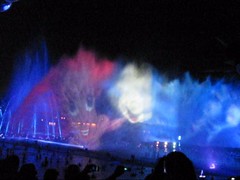 and the same preprogrammed emotional cues we’re well familiar with. The problem is compounded by the fact that anyone seeing this show will be doing so after the end of a full day at the Disneyland Resort. You’ve already heard the orchestral swells from The Little Mermaid multiple times today, Menkin’s ballad for Beauty and Beast will be on its third replay, and Aladdin’s Whole New World will by now sound very old and familiar. Disney seems to be under the impression that these musical cues will continue to reduce their audience to tears no matter how saturated they’ve become, and let me tell you, after spending only two days at the resort, they milk these songs for every last emotional drop. Then again, I wouldn’t be surprised if many people are reduced to tears again and again, given how many members of the population have their cultural maturity
and the same preprogrammed emotional cues we’re well familiar with. The problem is compounded by the fact that anyone seeing this show will be doing so after the end of a full day at the Disneyland Resort. You’ve already heard the orchestral swells from The Little Mermaid multiple times today, Menkin’s ballad for Beauty and Beast will be on its third replay, and Aladdin’s Whole New World will by now sound very old and familiar. Disney seems to be under the impression that these musical cues will continue to reduce their audience to tears no matter how saturated they’ve become, and let me tell you, after spending only two days at the resort, they milk these songs for every last emotional drop. Then again, I wouldn’t be surprised if many people are reduced to tears again and again, given how many members of the population have their cultural maturity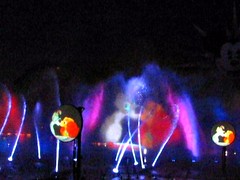 limited to Disney movies. (A quick defense: I think many Disney films are very rich aesthetic works of art that deserve high status in the cultural pantheon. Here’s one of my favorite movie reviews of Dumbo.)
limited to Disney movies. (A quick defense: I think many Disney films are very rich aesthetic works of art that deserve high status in the cultural pantheon. Here’s one of my favorite movie reviews of Dumbo.)
The point is this: the technology is wasted on the programming. Once the show runs out of its bag of new technical tricks (which after the first ten minutes a lot of the effects start becoming as recyclable as the music), World of Color very rapidly devolves into a self-indulgent advertisement. The few original parts of music written for the introduction and conclusion could be mistaken for a satiric parody of the Disney philosophy, the incessant invocations of “imagination” only revealing how imaginatively bankrupt the entire show actually is. Reconstruct World of Color in any major city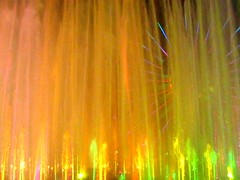 around the globe and run a nightly evening program with Holst’s The Planets, and you’ll have a national treasure attracting worldwide media attention. And you know what else? I think that if Walt Disney was still alive and calling the shots, that description would much more closely match the final product of World of Color. A brand new Fantasia scripted specifically to take advantage of the unique properties afforded by this brilliant multidimensional water canvas. That would have been worth an hour and a half of standing propped up against a banister for.
around the globe and run a nightly evening program with Holst’s The Planets, and you’ll have a national treasure attracting worldwide media attention. And you know what else? I think that if Walt Disney was still alive and calling the shots, that description would much more closely match the final product of World of Color. A brand new Fantasia scripted specifically to take advantage of the unique properties afforded by this brilliant multidimensional water canvas. That would have been worth an hour and a half of standing propped up against a banister for.
However, if I were the one in charge, we’d hear a lot less of Dukas, and a lot more of Pink Floyd.
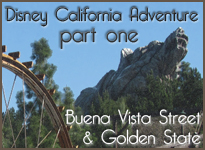
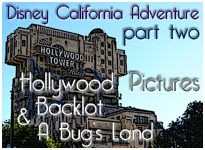
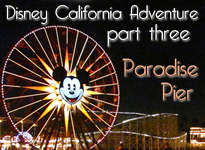


I’ve really been enjoying your California Adventure articles. Especially in this last update, I think you hit it on the nail: California Adventure is the park of mediocrity. I live a short twenty minutes from the park, and every time I make my four hour trips twice a month, I find myself rushing to escape DCA after just half an hour there.
My experience of the park never changes: enter with optimism, grow tired when I hit Paradise Pier (about halfway through my hour and a half “curtesy visit”), and then I find myself fast-walking to escape, which its horrible layout does not lend to easily.
This experience repeats itself with individual rides. I find myself rushing to the exit of the Little Mermaid ride after wasting my time on a 15 minute ride that should really be 5 (the ending scenes are pathetic, and it just CRAWLS through the layout). I regret wasting my time with Soarin’ by the time I get on the ride. The whole experience is just very time consuming. I can’t stand Tower of Terror’s pre-show; by the time I get to the ride, I just want it to be done so I can do something of better quality.
All the rides in the park just try to trap like quicksand into their sub-par offerings. I actually respect California Screamin’ as it cuts to the chase. It’s one of the few rides in the park that I don’t find myself dying for it to be over already by the time I reach the station. It’s unoffensive.
So many rides in the park seem to rely on the novelty of the first ride, however there is nothing interesting to keep return rides interesting from me. Tower of Terror, Soarin’, and many more–they all just feel so *meh* after the first time, with nothing new to offer the second time.
I find the Bellagio fountains at Vegas far superior to World of movie clips as well. So much wasted potential.
I’m interested to see what you write about Disneyland, as I actually like that park. 😉
PS: I think you would get some very interesting reply if you posted this on Micechat… You’ve probably heard of that notorious site as you’ve made some allusions to their complaints in your article. Their reactions to this would be pretty amusing.
I actually got a lot of my ‘common criticism’ of California Adventure from Wikipedia, but most of it seemed like something I had heard about the park from other sources beforehand. I’ve never been on Micechat, but I don’t doubt a lot of it could originate from there.
It’s interesting: some places we grow fonder towards with greater familiarity. Others we become more hostile towards. Normally for me I tend to see my opinions go up the more time I have with a certain ride or park because I start to understand it better and I can see it from all angles. It sounds like your opinion of California Adventure has only gone further south the more familiar it is to you. I wonder if that has something to do with the inherent nature of the artifice of the park. It has more ‘magic’ when you see and experience it fresh and oblivious for the first time, and always from the intended angle. Then the closer you look at it from different perspectives over time, the more it becomes flat and ordinary.
Hard to believe, after writing this series I sort of find myself looking forward to an eventual return visit to California Adventure. Partly because I’m curious to see how much has changed, and how much a renewed vision for the park can affect my perception of what’s already there. I like seeing the different ‘solutions’ designers can think up, judging how effective they are, and how they make the transition from blueprint to real world. I sort of wish I had gotten to visit before the announcement of the big make-over, when there was still the Sun Wheel, Maliboomers, Mulholland Madness, etc., just so my comparison could be complete.
I’m interested to see what I write about Disneyland, myself. I took away a lot of opinions, some very good, some very bad, and hopefully a lot of them attached to rides you wouldn’t be expecting. 😉
It’s funny, I work at DCA, and returning to work after reading these, I’ve a new perspective for certain things. There definitely is a lot of potential that they did not really tap into, and am curious how well this revamp will actually do.
I must comment on Screamin’, however. First, to point out the coaster is a LIM and not LSM launch. Seems trite and snooty to post that, but hey, a flywheel launch isn’t a hydraulic launch, and there are differences between the two. Also, from an operations standpoint (having worked at another amusement park prior to DCA), I personally hate the loose article bags and Disney’s overall loose article policy. It improves efficiency, but allows more error during the ride, like the backpack incident a few months ago. I believe no company has truly figured out the best way to handle loose articles yet.
That’s my two cents. Always enjoy reading the reviews.
Huh, I was surprised that I said it uses LSMs and not LIMs, but sure enough there I had written it. Thanks for pointing the mistake out, it’s now corrected. I must have typed LSM instinctively, maybe I was thinking of Maverick due to the mention of the lift/launch system.
I was half-thinking of mentioning that backpack incident, but decided not to because it seemed like that was definitely not a proper usage of the onboard loose items pouches, which was what I wanted to praise. I forget, do California Screamin’s have zippers? For small items I can’t really see how that’s a losing situation for anyone, unless there’s a high incidence of people forgetting their items after the ride. Since I like to take pictures while waiting in line (if there are any good shots) and up to the station platform, but I don’t feel comfortable leaving my camera behind where other people have access to it while on the ride, that pouch was an ideal solution for me.
Especially in an age where people bring smartphones with them that have their greatest usefulness during a day’s visit to pass the time while in line, requiring lockers up front at the entrance doesn’t seem to be a very effective loose items policy (especially if there’s a charge, lots of people won’t declare small loose items, and then be forced to pocket or hold onto them during the ride which increases the risk of loss). However, loose items cubbies on the unload platform are also not ideal, and are huge time wasters for dispatch times. At least as regarding small loose objects, I think Disney’s loose articles policy is the best I’ve ever seen at a park, bar none. Dollywood and Holiday World are also fairly effective, since they overstaff the platforms with attendants who will take your loose items for you, and in the case of HW put them in a free locker system. Not exactly the most cost-effective from an HR point of view, and this still tends to neglect the security of small valuable items that fit in a pocket that people don’t feel comfortable handing even to a uniformed stranger (wallet, phone, etc).
The backpack incident I agree probably indicated too liberal of a loose items policy. I actually remember a far worse situation one year on King’s Island’s Flight of Fear. Since they have separate and disconnected loading and unloading platforms but weren’t enforcing any sort of loose items check at the entrance, they were requiring everyone with purses, backpacks, or stuffed games prizes to leave them on the floor of the car for the ride. And that year they were launching it at the slowest possible speed as well, so there was a lot of hangtime over the first three inversions. How we didn’t loose our bags in still remains to me a mystery of physics. Especially on a ride with some moments of negative-G’s like California Screamin’, I’m surprised they’d allow large items that don’t fit in the pouches to be taken on board.
Wow, now I’m really rambling in response to what was only a small comment. Anyway, I’m really glad you’re enjoying my reviews, especially as you’re a cast member who would be way more familiar with the place than I.
Glad to hear the feedback. And as for ramble, I soaked up every word, sad as it is.
Screamin’ does not have zippers, just a simple elastic cord. Zippers would be a tad bit more ideal, along with a slightly larger pouch. But oh well. Perhaps that will be part of Phase 2 of this whole revamp. Finish up the rest of the Pier and stuff…
I’m fairly certain I remember riding some attraction in the past year that had zippers on the pouches, but I can’t remember exactly which one it was. I’m thinking it must have been at a Disney park.
Gah, I need to physically take notes if it’s going to take me nearly a year before I write these damn reviews.
Haha, I think taking notes at an amusement park would kind of take away from the experience. I’m all for assessing what the park did afterward, but when at the park I want to ride rides, not much else.
Well, I think it’s safe to assume that at this point my motivations for visiting a park are quite radically different from the average visitor’s, so I wouldn’t expect taking notes to be any sort of categorical imperative. And I still don’t take notes for precisely that reason; some Heisenbergian principle that taking notes while I’m at the park will affect my judgement of it. But given how my rate of visiting parks has exceeded the rate that I’m able to comment on them, I’ll need some form of note system in the future if I’m ever to remember all of the small details. The photos don’t always record everything.
(By the way, awesome name you’ve got.)
Rip paradise pier and hello Pixar pier